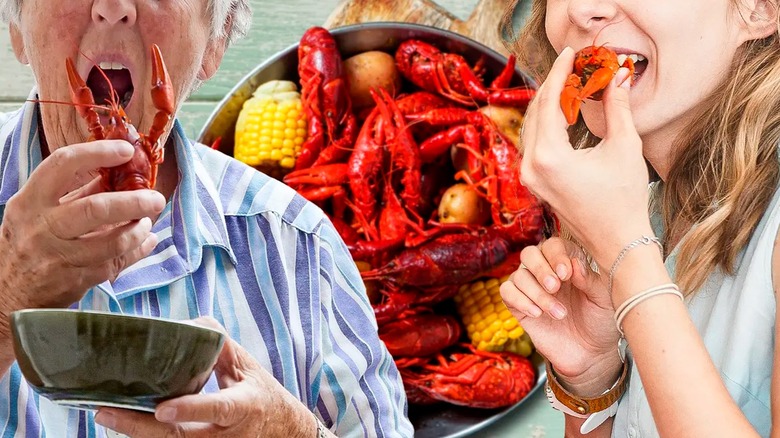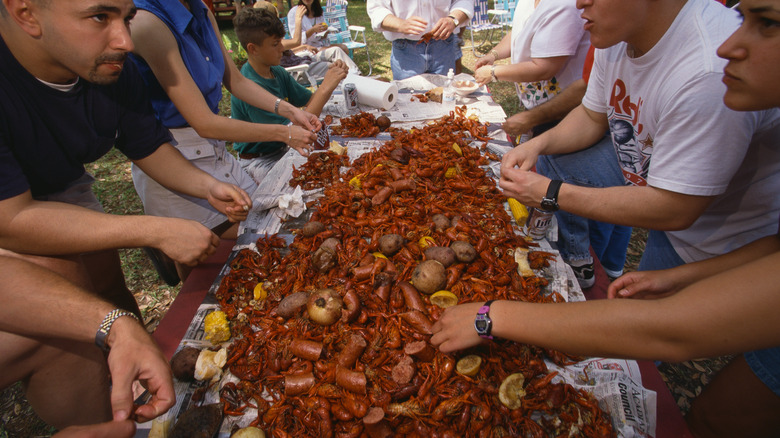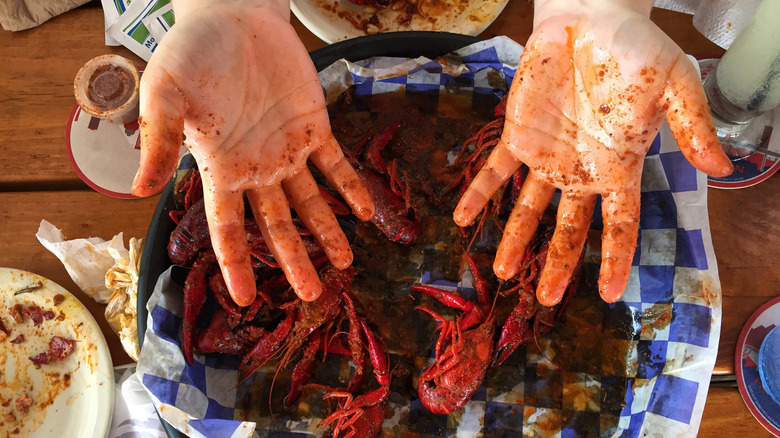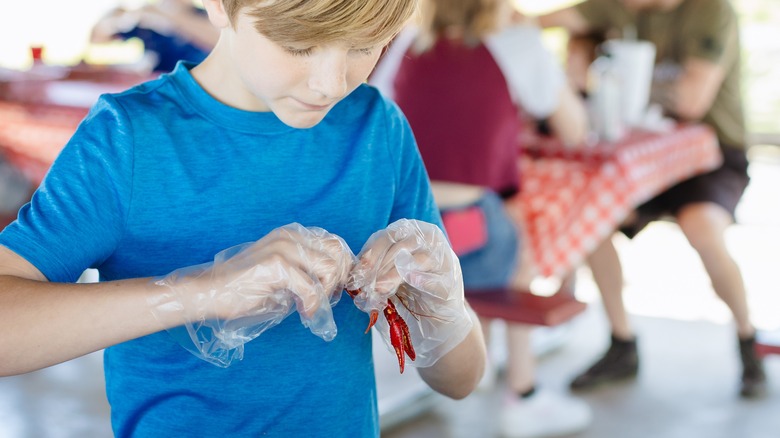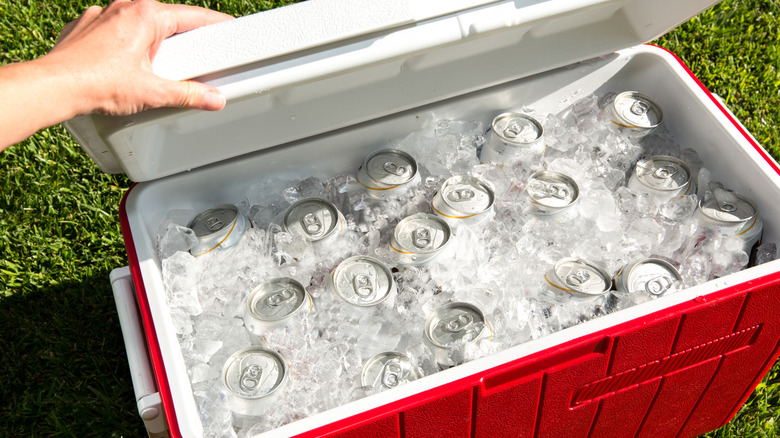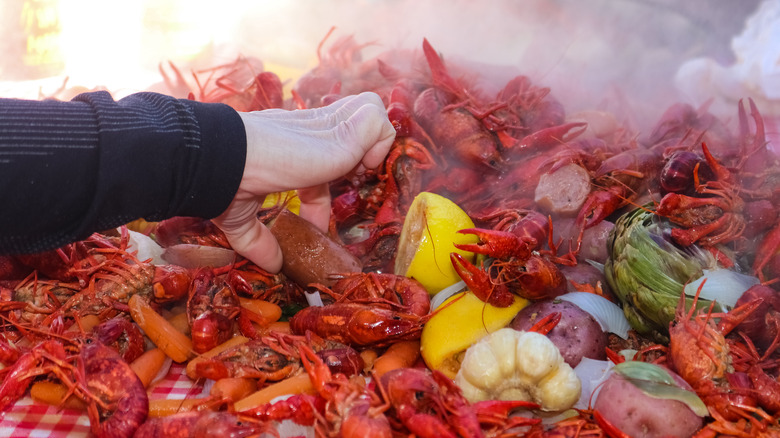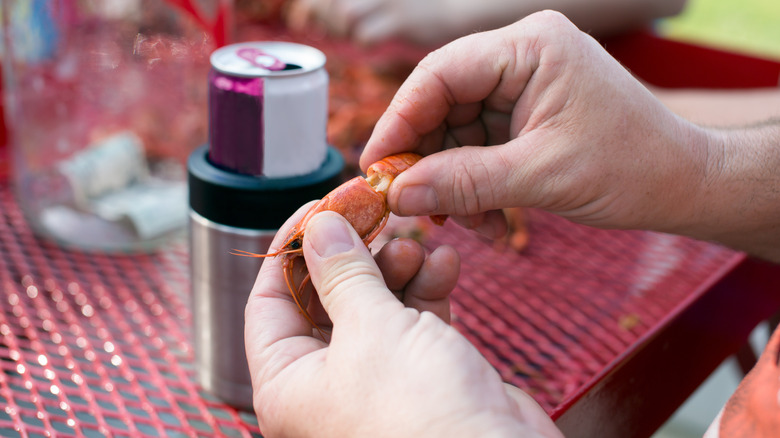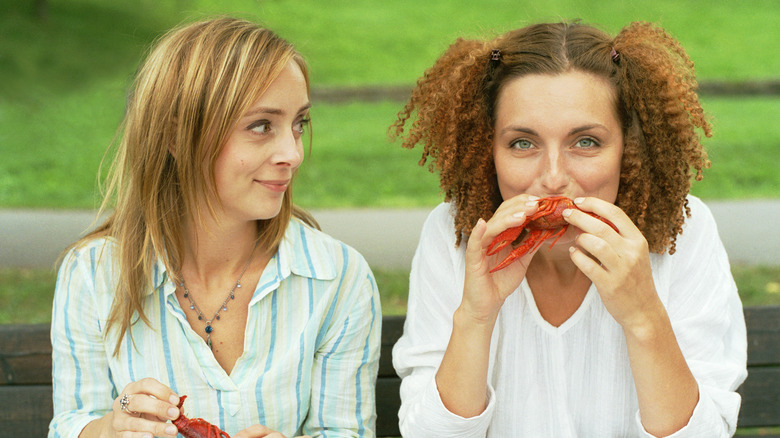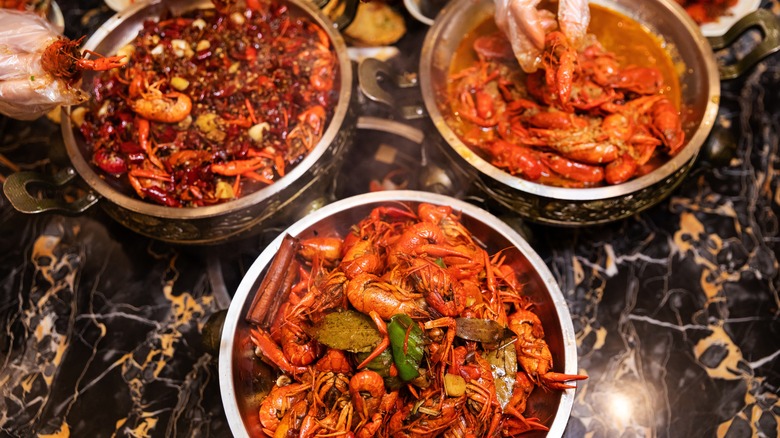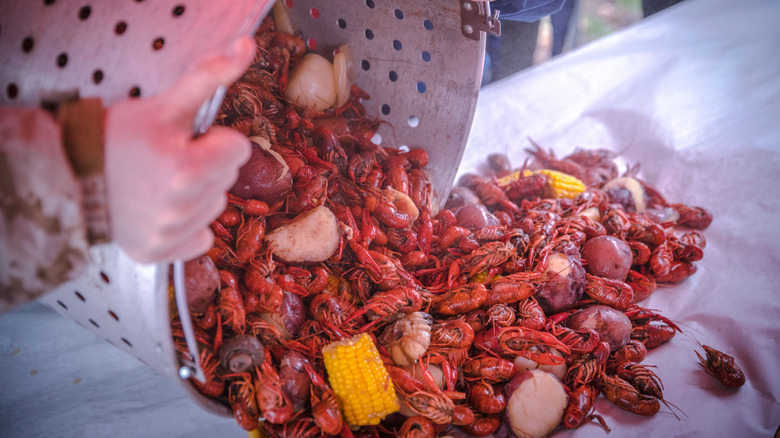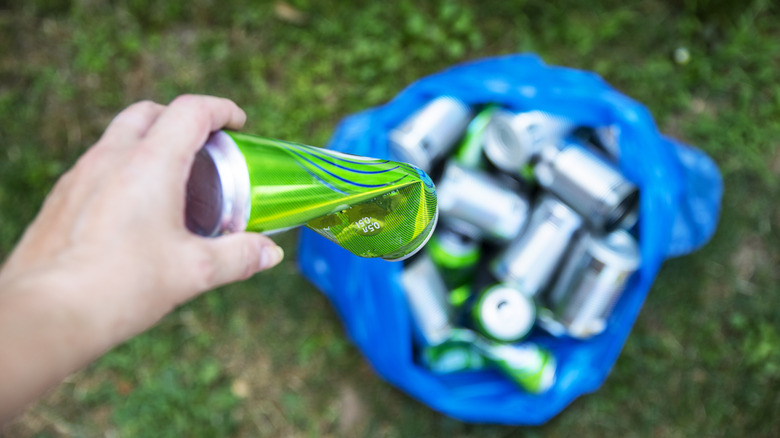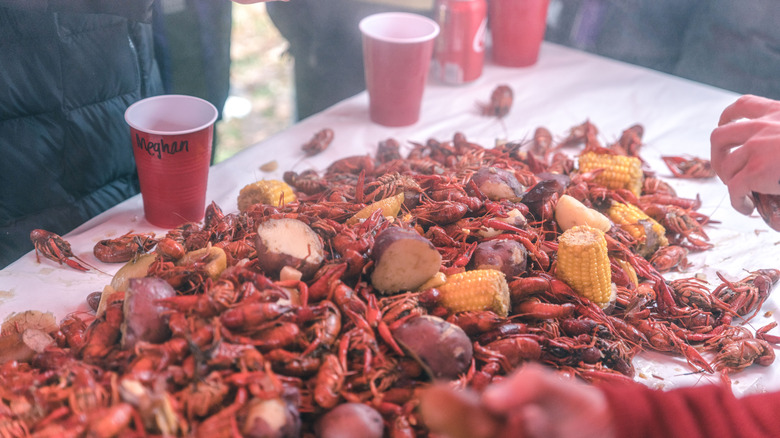11 Etiquette Rules To Follow At Your First Crawfish Boil, According To Experts
In the 1700s, Native Americans made use of their abundance in Southern Louisiana, using venison to catch the crawdads. Today, the crustaceans are still an integral part of Louisiana culture — the state is home to over 1,000 crawfish farms. Mardi gras celebrations center around crawfish, and, when a salty, coastal breeze carries a scent of the seasoned fruits of the Gulf Coast, residents know it's time to ring in the spring season.
Crawfish — affectionately dubbed "mudbugs" down South — are found on Michelin-rated menus, in eclectic bistros, and at festivals celebrating their significance. But most notably, the fiery red crustaceans prompt folks to gather together and celebrate springtime in their own backyards by hosting crawfish boils. If you're new to the Southern food scene, hosting or attending your first crawfish boil is arguably the most significant right of passage. It may seem daunting, but I've found an expert to make the experience fun and stress-free. Nicole Caridad Ralston, Ph.D — a lover of New Orleans food culture — has been writing about food history on her Instagram account Off the Eaten Path NOLA for nearly 10 years. She and myself — a former New Orleans resident and ardent devotee of Cajun and Creole cuisine — have teamed up to list the most important etiquette rules to follow at your first boil so you can enjoy a crawfish boil with confidence.
Be a good host
If you're hosting a crawfish boil for the first time, you undoubtedly want to create an experience that makes a mark in your community, where people can relax, have fun, and be themselves while celebrating the bounty of the Gulf Coast. Be sure to inquire with your guests and ask what they enjoy at a crawfish boil, whether it be certain seasonings, fixings or drinks. You don't necessarily have to cater to everyone's demands, but considering your guest's likes and dislikes is a quality of an excellent host.
Consider the time of year when planning your boil, and choose the best, biggest crawfish you can get your hands on. Fresh is best, but frozen crawfish will do in a pinch, as long as they're thawed correctly. If you need to keep fresh crawfish for a day or two, make sure to keep them at a constant 36 F to 46 F; they'll remain alive and maintain a fresh taste. Crawfish are cooked alive to reduce the risk of food-borne illness, and leaving them in tepid water or in the sun will undoubtedly lead to their untimely demise, resulting in sick and angry guests. To further ensure cleanliness, make sure there is an area set up for guests to wash their hands frequently and sanitizing wipes or spray for surfaces where food is kept. Ensuring your guests are happy and safe is crucial to throwing a successful boil and earning the coveted crown of ideal host.
Wear clothes that can get messy
There's a single, undeniable truth that can be said about every crawfish boil: You will get messy. I'm not talking about a spot of sauce or a dab of debris on your favorite shirt; this is the ultimate messy eating experience. Tearing open a crawfish involves an explosion of juices and seasonings, leaving gnarly stains on clothes. Prepare to be drenched in heavily seasoned broth, bits of crustacean, and buttery seafood boil sauce, since — to add to the messiness — crawfish boils are the perfect sauce-sampling opportunity.
Part of the excitement of a crawfish boil is their wild, unpredictable nature. To avoid any chaotic crawfish catastrophes when it comes to your garments, opt for clothes that you don't mind getting messy. If you'd prefer to keep all of your clothes looking nice and not sacrifice any to this fun yet slightly destructive event, don't opt for a plastic bib. Unfortunately, this blunder will have you sticking out as an obvious newcomer, likely ostracizing you from the group. Instead, choose black clothing on the day of the boil to make stains less noticeable so you can stay looking sharp throughout the event. Don't forget to remove any expensive or sentimental jewelry — especially rings and watches — before the boil, otherwise it might get lost in the depths of a deep crawdad pot.
Don't wear gloves
As I've already established, a crawfish boil is messy work, but that's a huge aspect of what makes it so enjoyable. The carefree nature of a real Louisiana crawfish boil involves getting down and dirty with the mudbugs, and gloves can seriously inhibit this intimate connection with nature's bounty. If you're at your first boil and you want to blend in as a seasoned regular to the Southern food scene, it's best to avoid wearing gloves. While some may choose gloves to limit irritation on sensitive skin, Nicole Caridad Ralston and I suggest you go all in and enjoy the experience to the fullest, as long as your hands can handle a little crustacean carnage. "Okay, this might be controversial," says Ralston, "but I just don't think gloves belong at crawfish boils. It's dirty work, but I think you need all your senses activated to get the most out of your crawfish."
Instead of gloves, bring along some unscented wet wipes to keep your hands tidy. You'll often find that wipes are readily available at crawfish boils, especially parties thrown at restaurants, where proper sanitation practices are the law. But, ultimately, the best advice when it comes to limiting messes at a crawfish boil is to just accept that it's a sloppy affair and roll with it. This way, you'll get the most out of the experience and have the time of your life.
Do bring drinks
Although there will likely be a plethora of drink options, it never hurts to bring your own to a boil so you can enjoy your favorites and share, especially if you're a newcomer to a time-honored event. Offering a bevvy is the best way to spark conversation and get to socializing. Most often, a boil is associated with beer or other alcoholic drinks, so don't shy away from bringing a sixer or a bottle of wine. Be sure to take advantage of this delectable pairing opportunity and choose the perfect alcohol pairing to go with boiled seafood.
Southerners are famous for their ability to bring the heat, typically adding literal pounds of seasoning to a boil, so you'll want something ice cold to tame the flavor of those fiery mudbugs. "Crawfish are full of spice and flavor," says Ralston, "so they need to be washed down with something bubbly, in my opinion; beer, sparkling wine, or sparkling water." Crawfish boils are known for their liberal quantities of alcohol, but if you prefer to stay sober, you can still enjoy a crawfish boil just as much as those tapping into the booze. Bring along your favorite canned sparkling water to complement the zesty seafood. No matter what, don't forget to sip on plain old water in between alcoholic drinks and crawfish bites. Alcohol, salty seasonings, and the hot sun can quickly turn a fun gathering into a medical emergency if you're not properly hydrated.
Don't be picky
It's no secret that the largest crawfish are the most delectable. The bigger the crawdad, the bigger chunks of juicy meat are stowed away inside, just waiting for you to start cracking and slurping. But in a typical sack of crawdads, there's plenty of shrimpy ones floating among the big kahunas. While not everyone would agree to this etiquette rule, I find it's always the most polite move to pluck away at random, saving some of the plumpest of the bunch for other guests at the boil. If fellow partygoers notice that you're hoarding the best looking crawfish, it could ostracize you from the group and lead the other guests to think that you're greedy. I get it — it's tempting to immediately reach for the best looking mudbug, but sharing the wealth is always the best move.
To extend your polite generosity even further, offer to help children and the elderly pick and break their crawfish. Choosing crawfish sometimes requires being a large and bold presence to reach in and grab as many as possible as well as dexterity when it's time to crack them open. A helpful hand at any gathering where all walks of life are present is always appreciated.
Break the crawfish in its natural midsection
If you're attending your first boil and have never eaten crawfish before, you might feel a little unnerved at the thought of attempting to dismantle the sea-bug in front of a slew of seasoned experts. But, fear not; the task is significantly less daunting than it appears. To avoid an embarrassing struggle during your first attempt to crack and peel a crawfish, simply locate the spot between the body and tail. You'll notice a line in its middle, like a waistline, separating the two parts. This is the spot to break. The crawfish comes apart easily when cracked open at its natural midsection. Make sure to grab some corn or a potato from the boil to place under your crawfish-cracking station to catch all the drippings.
Don't attempt to crack open the crawfish anywhere besides its little waistline, otherwise you'll likely end up with a mess of juices and scraps of crawfish meat all over. If you're still unsure of where to break the crawfish, don't be afraid to ask for help. This is a great way to get a conversation started. Experienced veterans in the world of Southern fare are more than happy to share their preferred methods for tapping into juicy, irresistible crawfish meat.
Suck the heads
Of all of the daunting aspects of a crawfish boil, sucking the heads of the crawfish might be the most intimidating of all. Customs that some might find strange are as ordinary as a sunny day in the South, and having an open mind makes the experience much more special. Ralston assures newcomers to the world of crawfish that this step is necessary, and far less weird than it appears at first glance. She explains that seasoned broth collects inside the head, and the only way to ensure that you're getting the full, flavorful experience is to suck the crawfish's heads. After sucking the seasonings and broth out, if there are any little morsels left behind, you can peel the crawfish head to get to the goodness inside.
There exists some confusion from those who aren't as familiar with crawfish over whether eating the heads is safe or not. Eating the crawfish's head is absolutely safe, and arguably the most flavor part to boot. Contrary to the initial assumption of most first-time crawfish eaters, crawfish don't have brains. Instead, what you're eating when you eat the head of a crawfish is its hepatopancreas, which is similar to the liver of mammals. So essentially, eating the crawfish's head is like indulging in a sort of seafood foie gras. This organ contains flavors and textures not found in the tail and shouldn't be cast aside and wasted.
Get ready to be communal
The beauty of a crawfish boil is its ability to bring people together; those from all walks of life revel in the delicious festivities inspired by wholesome mudbugs. No one is immune to the giddy excitement that a neighborhood boil invokes, from young to old and rich to poor. Since the crawfish boils of Louisiana, Texas, and beyond are known to be large affairs, there's a good chance that you won't know every soul in attendance. Instead of harping on this fact — maybe even letting shyness take over and choosing not to attend a boil — embrace it.
"Usually at a boil, you're standing up next to people you may or may not know, feasting on a giant table of boiled crawfish and fixings," says Ralston. "There's no privacy at these things, so be ready to slurp and suck next to potential strangers." If you're new to a neighborhood, these parties are a great way to get to know folks in your community. Southerners are known for their casual, laissez-faire attitude, and you'll likely find that this is a contagious mindset (especially when drinks are flowing). It's not uncommon for everyone to leave a crawfish boil with at least one or two new friends for life.
Get creative with your flavors
Whether you're hosting or attending a boil, there's plenty of opportunity to be creative. Although crawfish are the main feature of a boil, the fixings are nearly as important. You'll always find the usual sides, but sometimes the more inventive sides are the most popular. So in order to get the creative juices flowing along with that delicious seafood broth, bring along tasty additions to get the party talking. You may even introduce a fellow partygoer to their new favorite crawfish accompaniment.
Ralston's favorite unconventional fixings include sweet potatoes, pineapple, dumplings, mushrooms, and Brussels sprouts. Cauliflower is another popular option outside the standard fare found at a boil. If you're the one hosting the gathering, consider thinking outside the box and adding a unique cultural crossover element. Houston's Viet-Cajun-style crawfish boils are always a hit, bringing something a little different to the massive crawfish-covered table. Instead of the usual Southern seasonings and sides of the deep South, these boils can involve ginger, scallions, lemongrass, fresh garlic, and oranges. Or, from Southern China, try a spicy Sichuan Ma La-style boil, chock full of dried chili peppers, star anise, peppercorn, and chili paste.
But don't forget tradition
When it comes to a Louisiana crawfish boil, tradition is as integral to the experience as the crawfish themselves. While adding creative fixings and unique seasonings adds a little spice and zest to the experience — both literally and figuratively — it's important to keep the traditional aspects of the party alive and flourishing.
Ralston suggests that every boil must contain these standard accompaniments: potatoes, corn, sausage, garlic, and onion. In addition to the food that everyone expects to find at a boil, a large, newspaper-lined table to eat off of is a must. Crawfish boils require a more intimate, communal way of eating than a typical barbecue or American backyard cookout. Instead of guests shuffling off to sit at tables with their friends and family, a large, central table brings everyone together. Beer is also a must, unless your boil is specifically booze-free. Nothing beats a bite of succulent crawfish meat followed by a swig from an ice cold beer on a hot Louisiana day, so be sure not to forget this important ingredient for a great traditional boil.
Offer to help clean up afterwards
Once everyone has had their fill and the unfortunate time comes to part ways, it pays to lend a helping hand. Crawfish boils get messy quickly, but if everyone offers to tidy up, clean up is a breeze. Offer to pick up cans and trash, sweep up any crawfish debris, and put away any leftover food. Any uneaten crawfish will need to be peeled before freezing and stowing away, so volunteer to lighten the host's load of tedious tasks and help peel the mudbugs.
If you help clean up after the party, your good deeds may not go unappreciated; the host may bestow upon you a portion of the uneaten crawfish. While leftover crawfish may seem unappealing outside of a festive boil, there are a plethora of recipes worth creating that feature the crustaceans. First, reheat the crawfish in a steamer basket to keep their meat tender and juicy. Use the peeled, leftover crawfish for a cajun crawfish pie, where the shellfish and seasonings from the boil can live a second life. Crawfish butter is a vibrant condiment come summertime, and all it requires is the leftover seafood, Cajun spice, and your favorite butter. To enjoy a repeat of the crawfish boil you just attended, invite folks over the following day to craft these recipes with the leftovers, sending everyone home with a little homemade treat.
Methodology
I've attended my fair share of crawfish boils when I lived in New Orleans, and I haven't been to as lively a party since. Not only is the fresh, home cooked food delicious, but it's representative of the cultural amalgamation that defines the nation. The company of friends and neighbors at such a party is something special and unique to the Southern United States.
Attending your first boil can seem daunting, which is why I collaborated with Nicole Caridad Ralston — food blogger, social justice advocate, and author of an upcoming children's book about the cultural influences of New Orleans cuisine — to shed some light on the world of Southern cooking and festivities. Together, we used our firsthand experiences to cultivate this list of dos and don'ts to help those planning to host or attend a crawfish boil avoid any embarrassing mishaps or cultural faux pas. While these etiquette rules are based on the judgment and experience of Ralston and myself, they are by no means absolutely necessary to have a memorable experience at a crawfish boil. That being said, use this list as a guide to maximize your enjoyment at your first boil and feel like one of the locals, despite where you're from. Make friends, enjoy the flavors of the South, and let loose as you take part in this wholesome cultural experience celebrating some of the South's most delectable cuisine.
